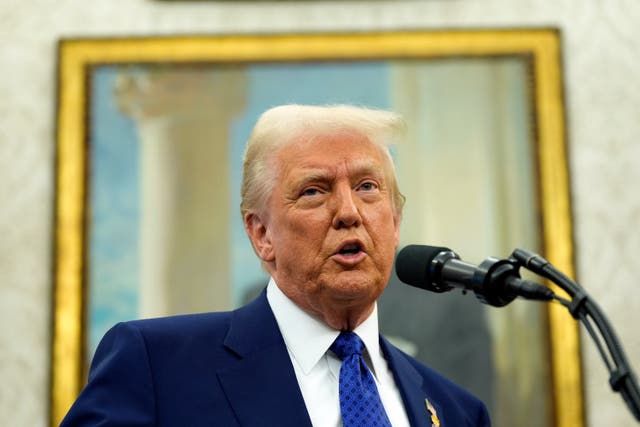Trump set to announce reciprocal tariffs on US trading partners
Mr Trump posted on his social media site that there would be a news conference in the Oval Office on the tariffs on Thursday afternoon.

President Donald Trump said he will soon announce increases on US tariffs to match the tax rates that other countries charge on imports.
“TODAY IS THE BIG ONE: RECIPROCAL TARIFFS!!!” Mr Trump posted on his social media site, Truth Social. “MAKE AMERICA GREAT AGAIN!!!”
Mr Trump later posted that there would be a news conference in the Oval Office on the tariffs on Thursday afternoon.

The prospect of a dramatic hike on tariffs could send shockwaves through the world economy, possibly depressing growth while also causing inflation to intensify.
Mr Trump has maintained that such tariffs will help to create domestic factory jobs, but most economists say they would effectively be a tax increase on US consumers that would add to inflationary pressures.
The Republican president has openly antagonised multiple US trading partners over the past several weeks, levying tariff threats and inviting them to retaliate with import taxes of their own that could send the economy hurtling into a trade war.
Mr Trump has put an additional 10% tariff on Chinese imports due that country’s role in the production of the opioid fentanyl.
He also has readied tariffs on Canada and Mexico, America’s two largest trading partners, that could take effect in March after being suspended for 30 days.
On top of that, on Monday, he removed the exemptions from his 2018 steel and aluminium tariffs.
And he has mused about new tariffs on computer chips and pharmaceutical drugs.
The European Union, Canada and Mexico have countermeasures ready to inflict economic pain on the US in response to Mr Trump’s actions, while China has already taken retaliatory steps with its own tariffs on US energy, agricultural machinery and large-engine autos as well as an antitrust investigation of Google.
Mr Trump has not specified how he defines the term “reciprocal”.
It is unclear whether his expected order would apply only to matching tariff rates or include other foreign taxes that he views as a barrier to exporting American goods.
The White House has argued that charging the same import taxes as other countries do would improve the fairness of trade, potentially raising revenues for the US government while also enabling negotiations that could eventually improve trade.
But Mr Trump is also making a political wager that voters can tolerate higher inflation levels.
Price spikes in 2021 and 2022 severely weakened the popularity of then-president Joe Biden, with voters so frustrated by inflation eroding their buying power that they chose last year to put Mr Trump back in the White House to address the problem.
Inflation has risen since November’s election, with the government reporting on Wednesday that the consumer price index is running at an annual rate of 3%.
The Trump team has decried criticism of its tariffs even as it has acknowledged the likelihood of some financial pain.
It says that the tariffs have to be weighed against the possible extension and expansion of Trump’s 2017 tax cuts as well as efforts to curb regulations and force savings through the spending freezes and staff reductions in billionaire adviser Elon Musk’s Department of Government Efficiency initiative.
But an obstacle for this approach might be the sequencing of the various policies and the possibilities of a wider trade conflict stifling investment and hiring amid the greater inflationary pressures.
Analysts at the bank Wells Fargo said in a Thursday report that the tariffs would likely hurt growth this year, just as the extended tax cuts could help growth recover in 2026.
“Tariffs impart a modest stagflationary shock to an economy,” the report said.
“The US economy entered 2025 with a fair amount of momentum, but we look for real GDP growth to downshift a bit over the next few quarters as the price-boosting effects of tariffs erode growth in real income, thereby weighing on growth in real consumer spending.”





